Pat Ongtowsaruk
Pat Ongtowaruk was born in Wales, June 23, 1933. He has lived in Wales his entire life. Pat is the elder in the village. He said he is 100% Eskimo. He is very proud of his heritage and culture. Pat spoke only Inupiaq until he was fourteen years old. He stills speaks it today but only with his peers.
He learned to hunt when he was ten years old. He actually started learning on a bowhead whale. This is the tradition that he learned from his father. He then taught his sons how to hunt, not just whales but all animals, fish, and birds that live in the Bering Strait. There are different times to hunt different animals, he said. The bowhead whale is an April hunt when the shore ice only goes out a mile or so. This is called the spring hunting season. There are other whales that come through the Bering Strait later in the spring and summer.
Pat spoke of skin boats called umiaks. They start with wooden frames. They then talked 3-4 walrus skins, which need to be stretched and dried. After that, the skins need to be softened before they can be stretched over the frame. The umiak was mainly used until only about 30 years ago. Today, modern boats are used. The boats to hunt in are small though. Only six to eight men are in a boat. The women do not hunt. He has only seen three whales caught in his lifetime. Pat said many years ago, there were not many bowheads left, so they were not permitted to hunt but there are more now. He spoke of the Fish and Game people telling the people of Wales they can only hunt certain animals and only so many. He said this is not fair, but what can you do? The food brought in by the ³white man² is very expensive.
He used to make crafts many years ago but doesn¹t do it anymore though. He learned to carve ivory when he was about ten years old. They carve out of ivory, but also bone today. He said bone is a lot easier because it is softer. They had to carve to make money because there were no jobs sometimes.
Pat spoke at length about the dangers of the shore ice and the floating ice in the Bering Strait. There are two very strong currents. The ice starts to form in September and October. It gets very thick after that. He remembers people being lost out on the ice in his lifetime. It is also very windy. Sometimes polar bears would come in on the ice onto the beach. The snows also drift sometimes twenty feet high next to the houses.
Pat spoke of a legend where many starved. He said this was before his time. Today he has his children and grandchildren.
Pat was a very nice man who is proud of his people.

Pat has lived in Wales his whole life. He has a very positive outlook.

Chris interviewed Pat. Jill did the presentation at Butterfield School, Orange, MA.
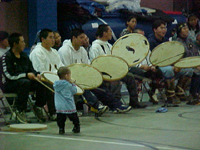
Pat spoke of the traditional dances. They were not allowed for many years. The now have an annual festival.

This is a lagoon with Siberia in the far background.

Pat lives on Main St. across from the IRA building.
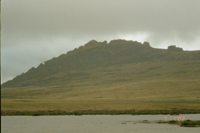
All of the people interviewed spoke of Razorback. It has a very strong presence.
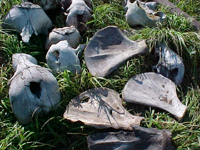
Pat spoke of learning to hunt from his father. He is turn taught his sons.These are scapulas and walrus skulls.
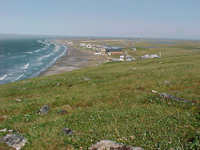
An overlook of the village. The Bering Sea is on the left. Little Diomede is approximately 25-30 miles into the Strait. Siberia is another 20 miles.
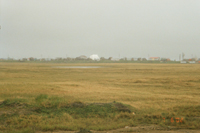
Here is a picture of Wales from a distance.
| 